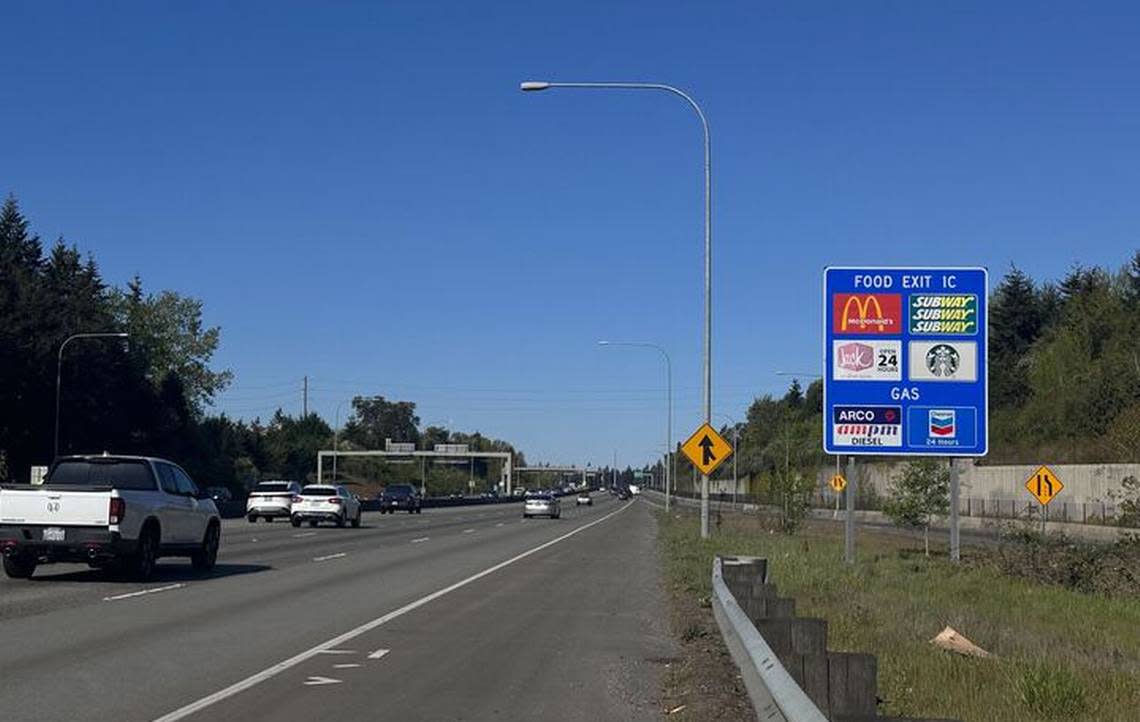You’ve seen those blue highway signs on I-5. Are they ads? A service? Who pays for them?
Drive up I-5 and you’ll see the same few logos on each highway information sign – Wendy’s, Shell, Holiday Inn Express, a Subway if you’re lucky. Maybe every few dozen miles, you’ll see a sign covered in logos you don’t recognize.
So who exactly decides which businesses to feature? Are the signs considered a public service, funded by the state, an attempt by cities to get travelers to stop in town, or advertisements paid for by the businesses themselves? Here’s what we found.
Who pays for freeway signs?
The blue boards, technically called Motorist Information Signs, are managed by the Washington State Department of Transportation. Cities with over 25,000 residents have veto power over new signs being built, but they rarely use it, according to Rebecca Kaska, a WSDOT traffic operations engineer who oversees the MIS program in the northwest region of the state.
“Anything that’s on a state route within a city that’s over 25,000, then I just run it by the city and ask them if they’re okay with signing,” Kaska said.
WSDOT pays for and maintains the signs themselves, but nearly every other cost is passed on to the business.
What does a highway sign cost?
For freeways that see more than 80,000 cars a day, getting your business on an MIS costs $455 a year for one direction, and $910 for both directions. A business has to pay $683 for a pair of signs, and $342 for one sign, on a freeway that sees fewer than 80,000 cars a day.
Highways without entrance and exit ramps have a different pricing structure – $364 for a sign in one direction and $182 for signs in both directions.
The business is responsible for providing WSDOT with the sign they want on the MIS. That adds roughly $1,000 to the cost. If a sign is damaged, the business needs to not only provide the replacement sign, but also pay a $115 fee.
That said, WSDOT is pretty strict about what’s allowed on a sign. It must be the business’s logo, name or abbreviation, with almost no form of additional text allowed. A business can specify if it’s open 24 hours a day, and a gas station can mention the types of fuel it offers, but that’s about it.

How does WSDOT pick businesses to feature?
WSDOT picks the businesses to feature on an MIS on a first-come, first-serve basis.
“If there are already signs but the backboards are full, which we have I believe six logos max per board, they go on what we call a waitlist,” Kaska said.
Once an MIS is full, it rarely changes.
“Only if a business drops off – they go out of business or they decide not to participate in the program and say please remove our logos – or if they don’t pay,” Kaska said.
Businesses need to be open to all ages (sorry nightclubs) in order to be accepted by WSDOT. On interstate roads, restaurants, hotels and gas stations need to be within three miles of the upcoming exit, while tourist activities need to be within five. On non-interstates, any business just needs to be within five miles of the exit.
Businesses can apply on WSDOT’s website.
Sign eligibility requirements
Each category of business has its own criteria as well. In most cases, restaurants need to have sanitary restrooms, telephone access, at least ten parking spots and 20 seats, and be open for at least ten hours a day, six days a week in order to be featured on a sign.
Gas stations have to provide fuel, oil, water and tire repair services. They also need to have on-premise restrooms, phone access and be open for 16 hours a day, every day of the week.
Hotels and pharmacies have fewer criteria, although only 24-hour pharmacies qualify.
A tourist destination can also be featured on a sign, but it needs meet at least one of three criteria: it gets most of its income from out of town traffic, it’s a designated national or state historic landmark, or it’s an official, city-designated commercial district.
Why do highway signs vary?
You might have noticed that some cities’ signs feature only local businesses while some feature the same ten nationwide chains. Any variation from city to city is a result of the local business landscape and citywide ordinances, according to Kaska.
“That is nothing that we control,” Kaska said. “That is basically going to be the city. I don’t know if you’ve heard about some of the cities, these little quaint towns and such, they don’t want chain restaurants there so they have restrictions.”
